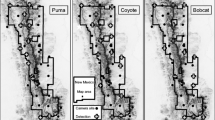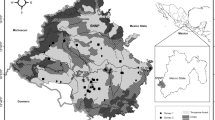Abstract
Interspecific competition within a carnivore guild can result in segregation along dietary, spatial, and temporal scales. Species interactions and resulting avoidance behavior can change seasonally as landscape features and resource abundance may fluctuate. In this study, we examined a carnivore guild in the Pantanal wetland of Brazil to determine whether temporal niche partitioning was a mechanism for coexistence, and if this differed between the wet and dry season. We used camera trapping data to fit kernel density functions of time observations for five species of carnivores to determine activity patterns. We calculated the coefficient of overlap between all species-pair’s activity patterns. Our results found support for temporal segregation among this carnivore guild, with stronger segregation evident during the dry season. Jaguars and pumas showed large overlap in activity in both seasons, while all three mesocarnivores (ocelot, tayra, and crab-eating fox) showed temporal avoidance toward pumas. Mesocarnivores displayed segregating temporal patterns between pairs in both seasons. Temporal segregation is a mechanism for coexistence within this carnivore guild, suggesting increased competition between species especially during the dry season. To maintain carnivore populations, a broader knowledge of interspecific interactions and how this may affect species, utilization or avoidance of habitats is needed. Given the complexities of interspecific interactions among carnivores, conservation efforts should address the needs of the entire guild rather than focus on a single species.



Similar content being viewed by others
References
Asensio N, Gómez-Marín F (2002) Interspecific interaction and predator avoidance behavior in response to tayra (Eira barbara) by mantled howler monkeys (Alouatta palliata). Primates 43:339–341
Astete S, Marinho-Filho J, Kajin M, Penido G, Zimbres B, Sollmann R, Jácomo A, Tôrres N, Silveira L (2017) Forced neighbours: Coexistence between jaguars and pumas in a harsh environment. J Arid Environ 146:27–34
Azlan JM, Sharma DS (2006) The diversity and activity patterns of wild felids in a secondary forest in Peninsular Malaysia. Oryx 40:36–41
Bezerra BM, Barnett AA, Souto A, Jones G (2009) Predation by the tayra on the common marmoset and the pale-throated three-toed sloth. J Ethol 27:91
Broekhuis F, Grünewälder S, McNutt JW, Macdonald DW (2014) Optimal hunting conditions drive circalunar behavior of a diurnal carnivore. Behav Ecol 25:1268–1275
Caro TM, Stoner CJ (2003) The potential for interspecific competition among African carnivores. Biol Conserv 110:67–75
Cavalcanti SM, Azevedo FD, Tomás WM, Boulhosa RL, Crawshaw PG Jr (2012) The status of the jaguar in the Pantanal. Cat News Spec Issue 7:29–34
Dalerum F, Cameron EZ, Kunkel K, Somers MJ (2009) Diversity and depletions in continental carnivore guilds: implications for prioritizing global carnivore conservation. Biol Lett 5:35–38
De Oliveira TG, Pereira JA (2014) Intraguild predation and interspecific killing as structuring forces of carnivoran communities in South America. J Mamm Evol 21:427–436
De Abreu UGP, McManus C, Santos SA (2010) Cattle ranching, conservation and transhumance in the Brazilian Pantanal. Pastoralism 1:99–114
Donadio E, Buskirk SW (2006) Diet, morphology, and interspecific killing in Carnivora. Am Nat 167:524–536
Dröge E, Creel S, Becker MS, M’soka J (2017) Spatial and temporal avoidance of risk within a large carnivore guild. Ecol Evol 7:189–199
Durant SM (1998) Competition refuges and coexistence: an example from Serengeti carnivores. J Anim Ecol 67:370–386
Emmons LH (1987) Comparative feeding ecology of felids in a neotropical rainforest. Behav Ecol Sociobiol 20:271–283
Farrell LE, Roman J, Sunquist ME (2000) Dietary separation of sympatric carnivores identified by molecular analysis of scats. Mol Ecol 9:1583–1590
Foster VC, Sarmento P, Sollmann R, Tôrres N, Jácomo AT, Negrões N, Fonseca C, Silveira L (2013) Jaguar and puma activity patterns and predator-prey interactions in four Brazilian biomes. Biotropica 45:373–379
Gantchoff MG, Belant JL (2016) Patterns of coexistence between two mesocarnivores in northern Patagonia in the presence of invasive hares and anthropogenic disturbance. Austral Ecol 41:97–105
Harmsen BJ, Foster RJ, Silver SC, Ostro LE, Doncaster CP (2011) Jaguar and puma activity patterns in relation to their main prey. Mamm Biol 76:320–324
Hayward MW, Slotow R (2009) Temporal partitioning of activity in large African carnivores: tests of multiple hypotheses. Afr J Wildl Res 39:109–125
Holland AE, Byrne ME, Bryan AL, DeVault TL, Rhodes OE, Beasley JC (2017) Fine-scale assessment of home ranges and activity patterns for resident black vultures (Coragyps atratus) and turkey vultures (Cathartes aura). PLoS ONE 12:e0179819
Holt RD, Polis GA (1997) A theoretical framework for intraguild predation. Am Nat 149:745–764
Karanth KU (1995) Estimating tiger Panthera tigris populations from camera-trap data using capture: recapture models. Biol Conserv 71:333–338
Karanth KU, Sunquist ME (1995) Prey selection by tiger, leopard and dhole in tropical forests. J Anim Ecol 64:439–450
Karanth KU, Srivathsa A, Vasudev D, Puri M, Parameshwaran R, Kumar NS (2017) Spatio-temporal interactions facilitate large carnivore sympatry across a resource gradient. Proc R Soc B 284:20161860
Lacher TE, Gonçalves HC (1988) Environmental degradation in the Pantanal ecosystem. Bioscience 38:164–171
Lashley MA, Cove MV, Chitwood MC, Penido G, Gardner B, DePerno CS, Moorman CE (2018) Estimating wildlife activity curves: comparison of methods and sample size. Sci Rep 8:1–11
Linnell JD, Strand O (2000) Interference interactions, co-existence and conservation of mammalian carnivores. Divers Distrib 6:169–176
Linnell JD, Swenson JE, Andersen R (2000) Conservation of biodiversity in Scandinavian boreal forests: large carnivores as flagships, umbrellas, indicators, or keystones? Biodivers Conserv 9:857–868
Lucherini M, Reppucci JI, Walker RS, Villalba ML, Wurstten A, Gallardo G, Iriarte A, Villalobos R, Perovic P (2009) Activity pattern segregation of carnivores in the high Andes. J Mammal 90:1404–1409
Macdonald D, Loveridge A (2010) The biology and conservation of wild felids (Vol. 2). Oxford University Press, Oxford
Meredith M, Ridout M (2014) Overview of the overlap package. R, Project, pp 1–9
Miller JR, Pitman RT, Mann GK, Fuller AK, Balme GA (2018) Lions and leopards coexist without spatial, temporal or demographic effects of interspecific competition. J Anim Ecol 87:1709–1726
Mourão G, Medri ÍM (2007) Activity of a specialized insectivorous mammal (Myrmecophaga tridactyla) in the Pantanal of Brazil. J Zool 271:187–192
O’Brien TG, Kinnaird MF, Wibisono HT (2003) Crouching tigers, hidden prey: sumatran tiger and prey populations in a tropical forest landscape. Anim Conserv 6:131–139
Oliveira TG, Tortato MA, Silveira L, Kasper CB, Mazim FD (2010) Ocelot ecology and its effect on the small-felid guild in the lowland neotropics. In: MacDonald DW, Loveridge AJ (eds) Biology and conservation of wild felids. Oxford University Press, New York, pp 559–580
Osorio C, Muñoz A, Guarda N, Bonacic C, Kelly M (2020) Exotic prey facilitate coexistence between Pumas and Culpeo Foxes in the Andes of central Chile. Diversity 12:317
Porfirio G, Sarmento P, Foster V, Fonseca C (2017) Activity patterns of jaguars and pumas and their relationship to those of their potential prey in the Brazilian Pantanal. Mammalia 81:401–404
R Core Team (2016) R: a language and environment for statistical computing. R Foundation for Statistical Computing, Vienna, Austria. https://www.R-project.org/
Ramesh T, Kalle R, Sankar K, Qureshi Q (2012) Dietary partitioning in sympatric large carnivores in a tropical forest of Western Ghats, India. Mammal Study 37:313–321
Rich L, Miller D, Robinson H, McNutt J, Kelly M (2017) Carnivore distributions in Botswana are shaped by resource availability and intraguild species. J Zool 303:90–98
Ridout MS, Linkie M (2009) Estimating overlap of daily activity patterns from camera trap data. J Agric Biol Environ Stat 14:322–337
Romero-Munoz A, Maffei L, Cuéllar E, Noss AJ (2010) Temporal separation between jaguar and puma in the dry forests of southern Bolivia. J Trop Ecol 26:303–311
Rovero F, Zimmermann F (2016) Camera trapping for wildlife research. Pelagic, Exeter
Rowcliffe JM, Field J, Turvey ST, Carbone C (2008) Estimating animal density using camera traps without the need for individual recognition. J Appl Ecol 45:1228–1236
Rowcliffe JM, Kays R, Kranstauber B, Carbone C, Jansen PA (2014) Quantifying levels of animal activity using camera trap data. Methods Ecol Evol 5:1170–1179
Santos F, Carbone C, Wearn OR, Rowcliffe JM, Espinosa S, Lima MGM, Ahumada JA, Gonçalves ALS, Trevelin LC, Alvarez-Loayza P (2019) Prey availability and temporal partitioning modulate felid coexistence in Neotropical forests. PLoS ONE 14:e0213671
Schoener TW (1974) Resource partitioning in ecological communities. Science 185:27–39
Scognamillo D, Maxit IE, Sunquist M, Polisar J (2003) Coexistence of jaguar (Panthera onca) and puma (Puma concolor) in a mosaic landscape in the Venezuelan llanos. J Zool 259:269–279
Sévêque A, Gentle LK, López-Bao JV, Yarnell RW, Uzal A (2020) Human disturbance has contrasting effects on niche partitioning within carnivore communities. Biol Rev 95:1689–1705
Silver SC, Ostro LE, Marsh LK, Maffei L, Noss AJ, Kelly MJ, Wallace RB, Gomez H, Ayala G (2004) The use of camera traps for estimating jaguar Panthera onca abundance and density using capture/recapture analysis. Oryx 38:148–154
Sunarto S, Kelly MJ, Parakkasi K, Hutajulu MB (2015) Cat coexistence in central Sumatra: ecological characteristics, spatial and temporal overlap, and implications for management. J Zool 296:104–115
Sunquist M, Sunquist F (2017) Wild cats of the world. University of Chicago Press, Chicago
Swanepoel LH, Lindsey P, Somers MJ, Van Hoven W, Dalerum F (2013) Extent and fragmentation of suitable leopard habitat in South Africa. Anim Conserv 16:41–50
Tobler MW, Carrillo-Percastegui SE, Pitman RL, Mares R, Powell G (2008) An evaluation of camera traps for inventorying large-and medium-sized terrestrial rainforest mammals. Anim Conserv 11:169–178
Torretta E, Serafini M, Puopolo F, Schenone L (2016) Spatial and temporal adjustments allowing the coexistence among carnivores in Liguria (NW Italy). Acta Ethol 19:123–132
Wang E, Donatti CI, Ferreira VL, Raizer J, Himmelstein J (2011) Food habits and notes on the biology of Chelonoidis carbonaria (Spix 1824)(Testudinidae, Chelonia) in the southern Pantanal. Braz S Am J Herpetol 6:11–19
Wolf C, Ripple WJ (2016) Prey depletion as a threat to the world’s large carnivores. R Soc Open Sci 3:160252
Zhao G, Yang H, Xie B, Gong Y, Ge J, Feng L (2020) Spatio-temporal coexistence of sympatric mesocarnivores with a single apex carnivore in a fine-scale landscape. Glob Ecol Conserv 21:e00897
Acknowledgements
The authors extend thanks to Lucas Leuzinger, his family, and all the staff of Fazenda Barranco Alto in the Pantanal for assistance and logistical support for this project. We are also grateful to members of the Jaguar Conservation Fund who participated in data collection and data processing. Partial Funding was provided by Nottingham Trent University.
Author information
Authors and Affiliations
Corresponding author
Ethics declarations
Conflict of interest
On behalf of all authors, the corresponding author states that there is no conflict of interest.
Additional information
Handling Editor: Luca Corlatti.
Publisher's Note
Springer Nature remains neutral with regard to jurisdictional claims in published maps and institutional affiliations.
Supplementary Information
Below is the link to the electronic supplementary material.
Rights and permissions
About this article
Cite this article
Finnegan, S.P., Gantchoff, M.G., Hill, J.E. et al. “When the felid’s away, the mesocarnivores play”: seasonal temporal segregation in a neotropical carnivore guild. Mamm Biol 101, 631–638 (2021). https://doi.org/10.1007/s42991-021-00110-9
Received:
Accepted:
Published:
Issue Date:
DOI: https://doi.org/10.1007/s42991-021-00110-9




